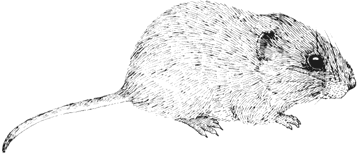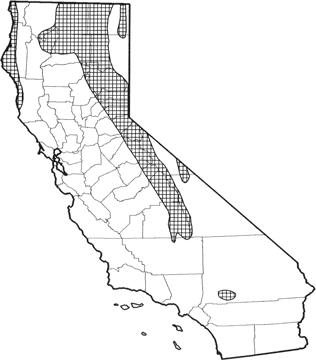
Long-tailed Vole
Distribution, Abundance, and Seasonality
In California, the long-tailed vole is found in the coastal zone from Mendocino Co. north to the Oregon border; inland it occurs in the Sierra Nevada, Cascades, White and Warner Mts., from the Oregon border south to Kern Co., and in the San Bernardino Mts. Common resident of herbaceous understories of many forest habitats. Abundant in montane riparian, as well as fresh emergent wetland, cropland, aspen, grassland, and wet meadow habitats. Occasionally found in montane chaparral, sagebrush, and bitterbrush habitats.

Range Map
Specific Habitat Requirements
Feeding: Feeds on a variety of herbaceous and woody plant parts including grasses, sedges, bulbs, and bark of shrubs. Major food items also have included flowers, seeds, roots, and insects (Cahalane 1947). Diet probably varies considerably from place to place. In winter, burrows under snow, feeding on leaves and bark of woody plants (Linsdale 1938). Most foraging is done on ground beneath shrubs.
Cover: Outside the nest, seeks cover in dense herbaceous vegetation or beneath shrubs. Burrows are constructed in soft soils, or within or beneath logs. Does not construct runways in grass as extensively as other voles (Smolen and Keller 1987).
Reproduction: Nests of plant fibers are constructed in burrows.
Water: May be found several hundred meters from water, but drinking water requirements are unknown.
Pattern: Prefers herbaceous vegetation, often in, but not restricted to, streamside grasslands. Often found in grassy areas in association with shrubs such as willow and snowberry.
Species Life History
Activity Patterns: Yearlong activity. No data found on daily patterns, but probably mainly nocturnal, with some daytime foraging activity.
Seasonal Movements / Migration: None.
Home Range: Home range averages 0.2 ha (0.5 ac) and ranges from 0.2-0.4 ha (0.3-1.0 ac) (Jenkins 1948) (Conley 1976) reported a peak density of 120/ha (491 ac). Populations probably do not fluctuate as much as those of M. montanus (Randall and Johnson 1979).
Territory: No data found.
Reproduction: Breeding statistics probably vary geographically, particularly between coastal and inland montane populations. Breeds from April to October, peaking from May to September. Litter size averages 5 or 6 (range 2-8). May have 3-4 litters per yr. No data found on gestation or weaning.
Niche: Probably eaten by a variety of predators, including foxes, coyotes, mustelids, and birds of prey. Competes with M. montanus (Randall and Johnson 1979). When population levels of M. montanus are low, M. Iongicaudus occupies grassy areas as well as shrubby areas (Randall and Johnson 1979).
Sources & References
California Department of Fish and Game, 1999.
California's Wildlife, Sacramento, CA.
Written by: P. Brylski, J. Harris, reviewed by: H. Shellhammer, edited by: R. Duke, S. Granholm
Cahalane, V. H. 1947. Mammals of North America. MacMillan Co., New York. 682pp. Conley, W. 1976. Competition between Microtus: a behavioral hypothesis. Ecology 57:224- 237. Hall, E. R. 1946. Mammals of Nevada. Univ. California Press, Berkeley. 710pp. Ingles, L. G. 1965. Mammals of the Pacific states. Stanford Univ. Press, Stanford, CA. 506pp. Jenkins, H. O. 1948. A population study of the meadow mice (Microtus) in three Sierra Nevada meadows. Proc. Calif. Acad. Sci. 26:43-67. Linsdale, J. M. 1938. Environmental responses of vertebrates in the Great Basin. Am. Midl. Nat. 19:1-206. Randall, J. A., and R. E. Johnson. 1979. Population densities and habitat occupancy by Microtus longicaudus and M. montanus. J. Mammal. 60:217-219. Smolen, M. J., and B. L. Keller. 1987. Microtus longicaudus. Mammal. Species No. 271. 7pp.
California Animal Facts | California's Wildlife